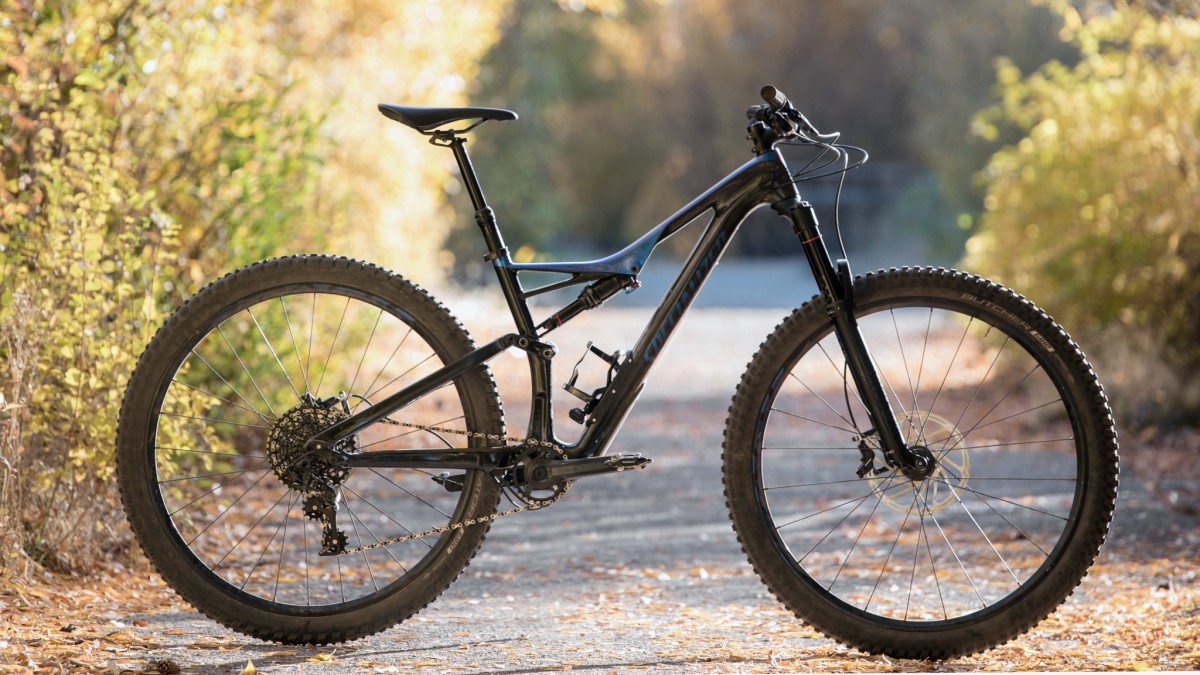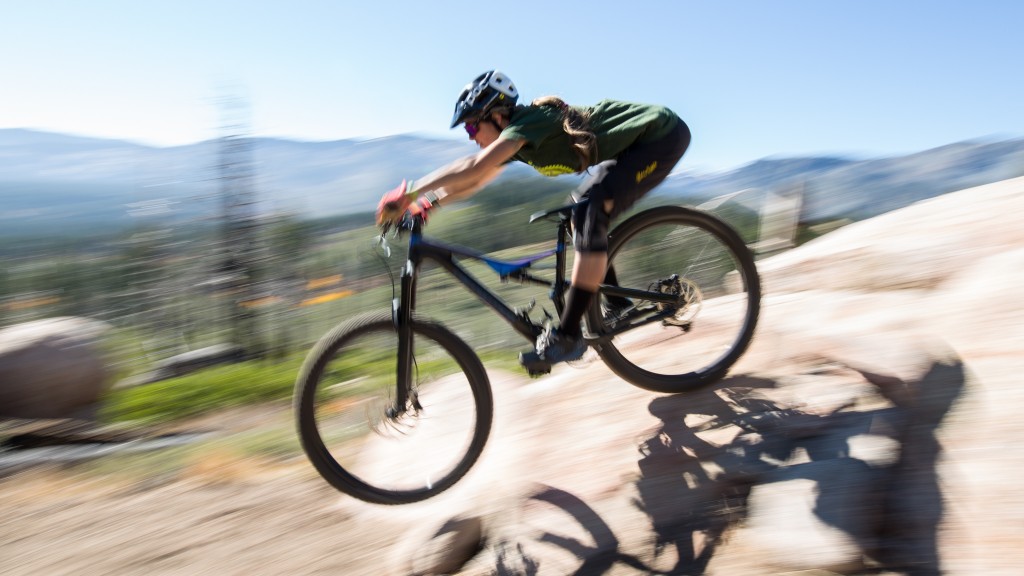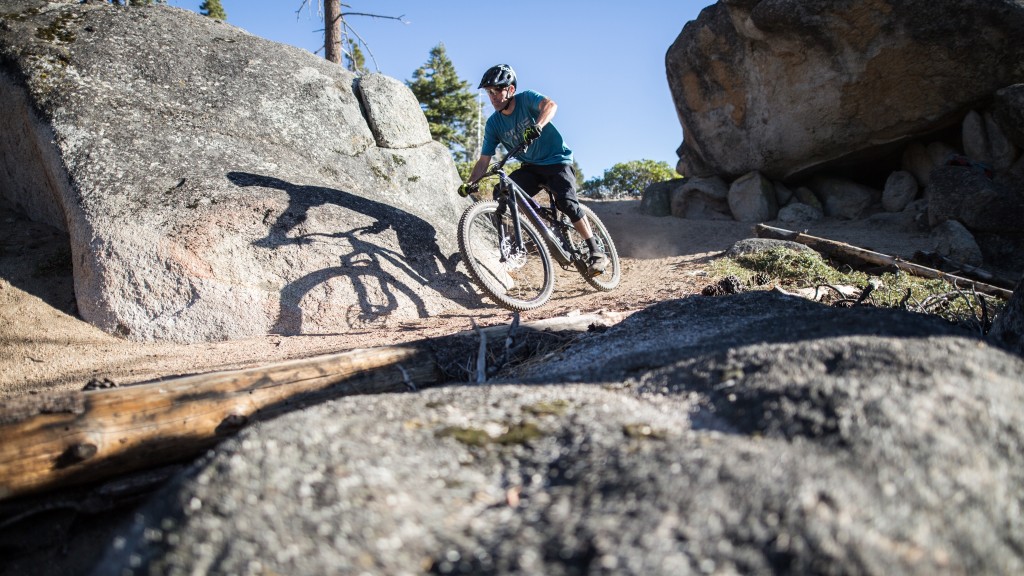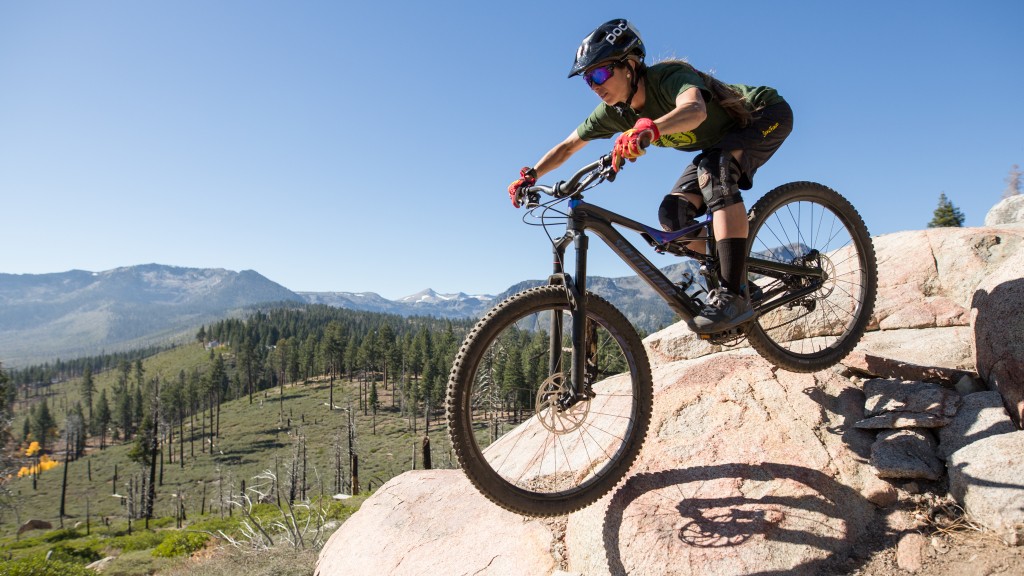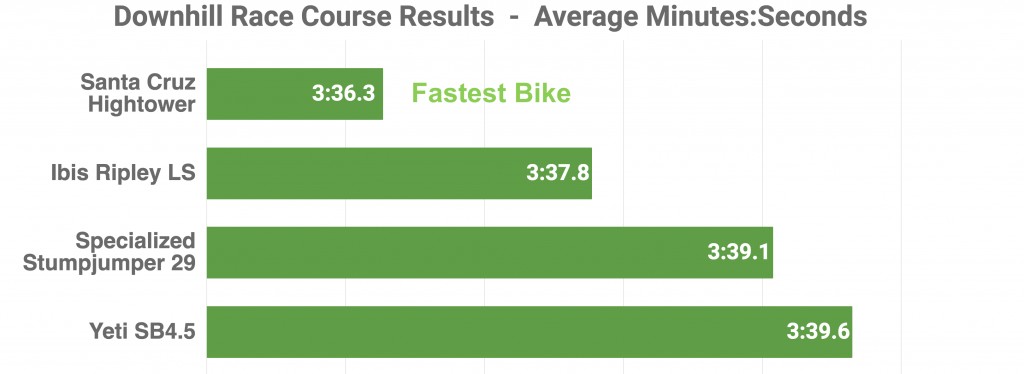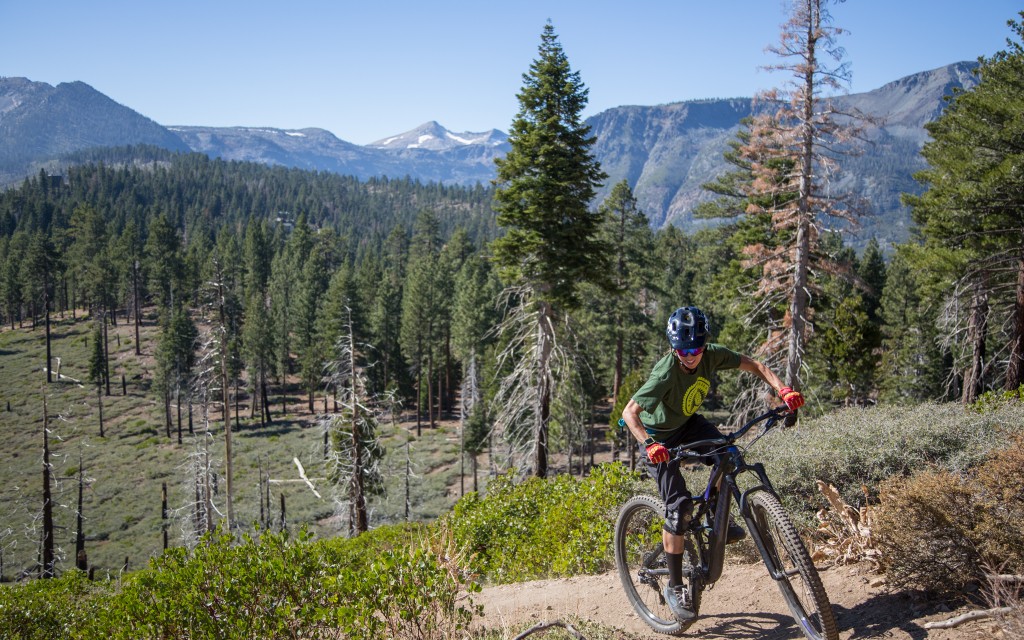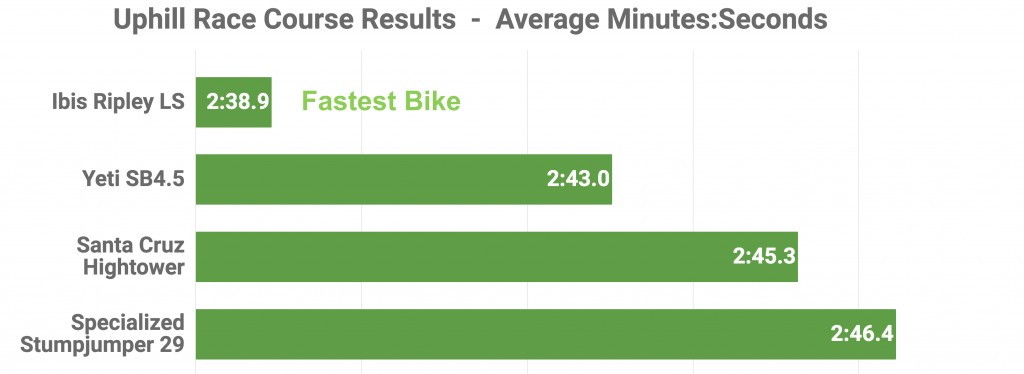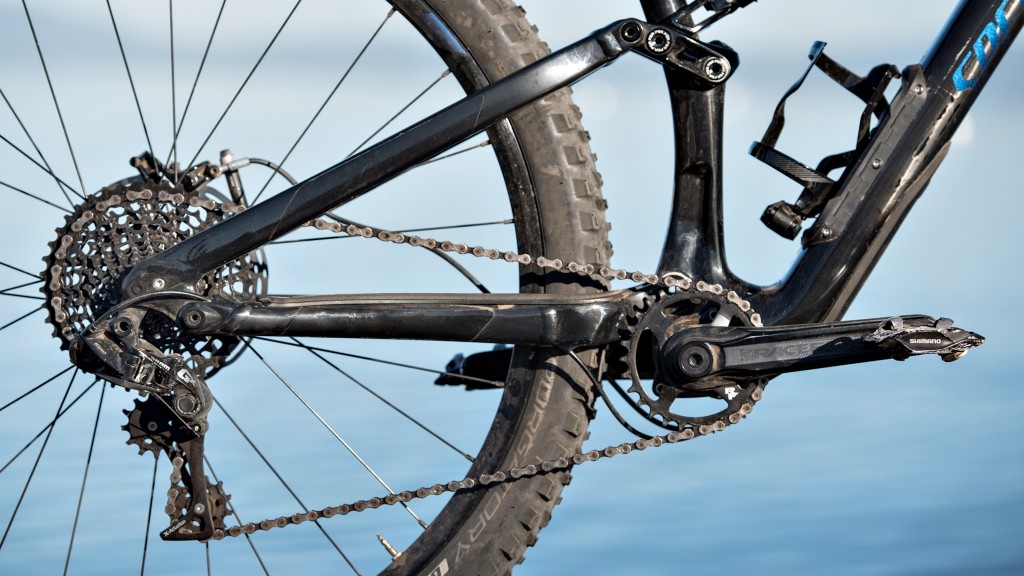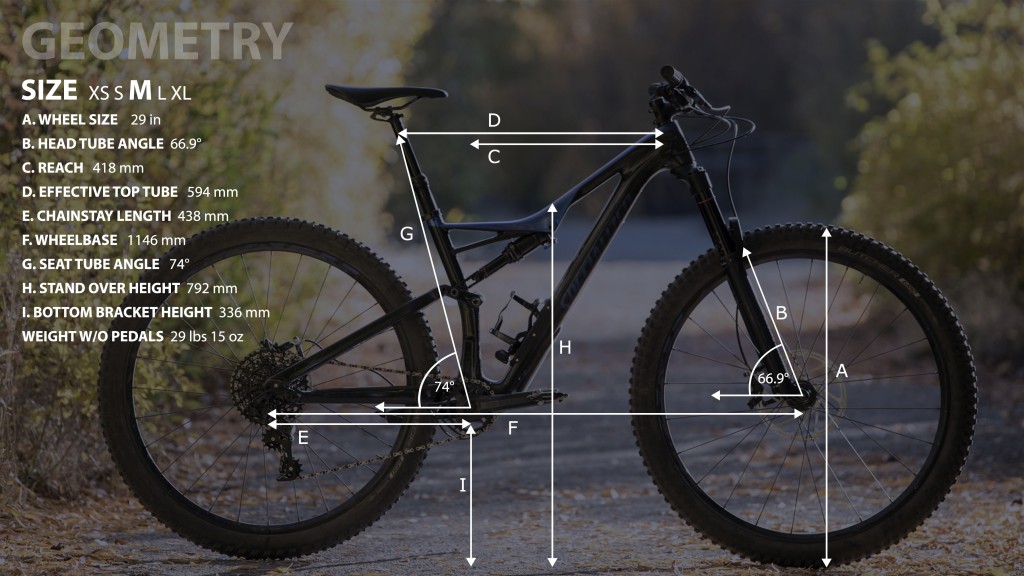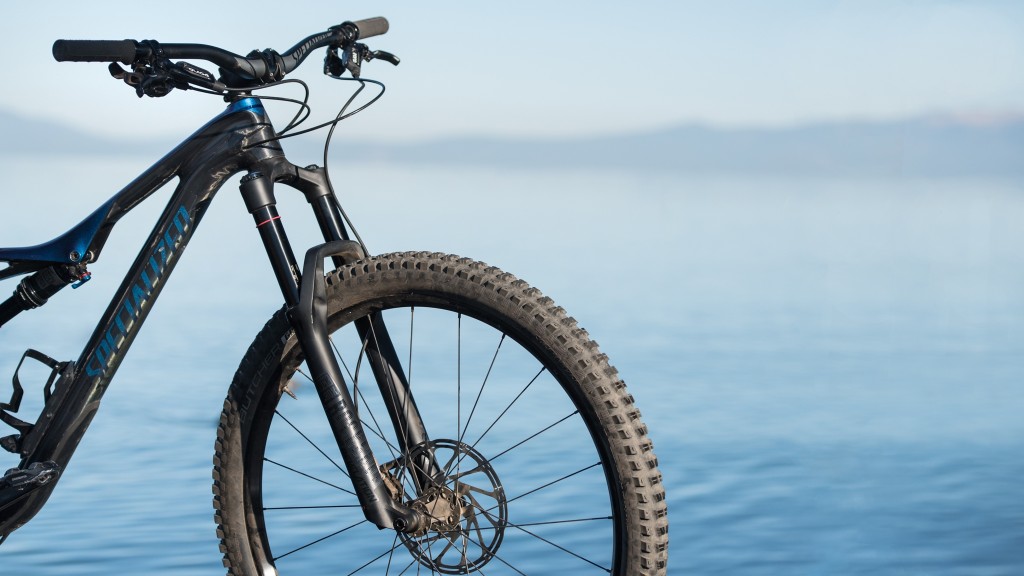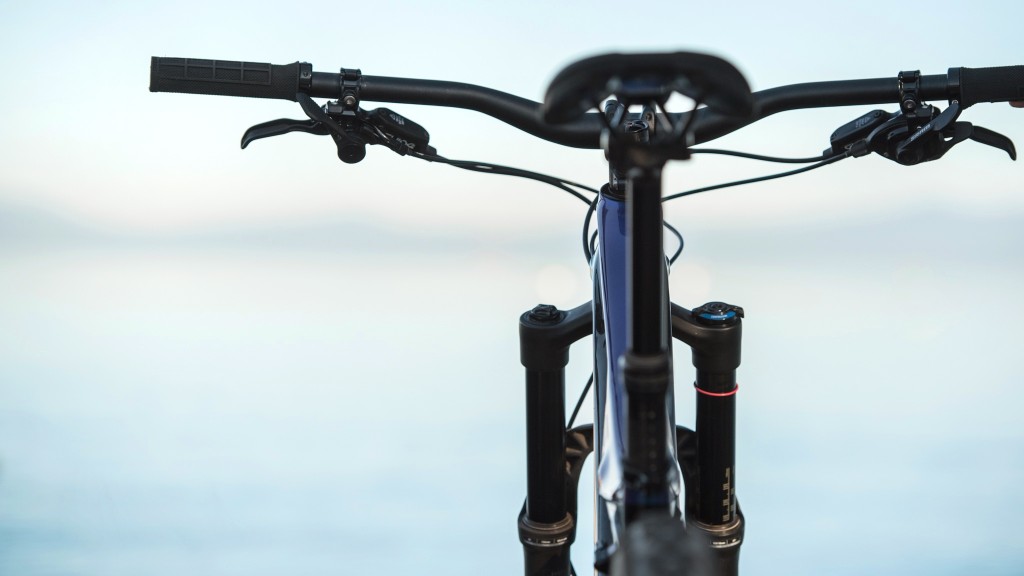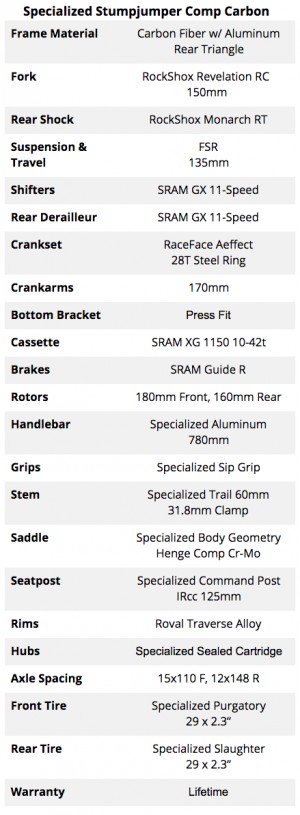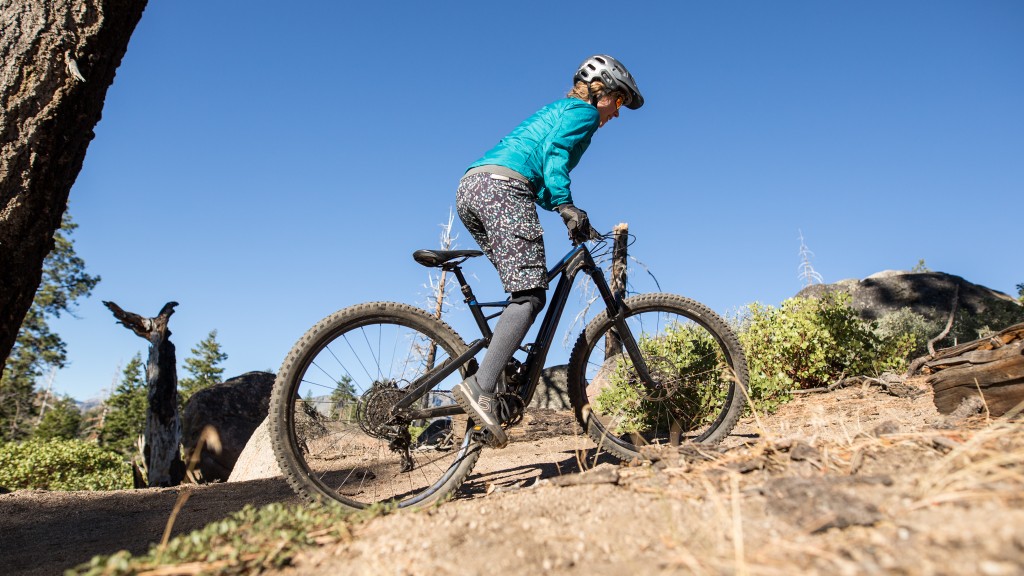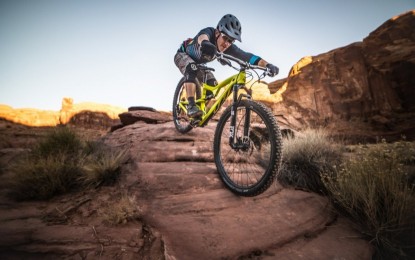The Specialized Stumpjumper Comp Carbon 29 is a capable and effective mid-travel trail bike. This bike has the skills and capability to tackle a wide range of terrain but lacks personality, comfort, or a lively feel. This 135mm travel 29er climbs effectively and can stand up to nasty terrain on the descent but the ride is jarring and fairly unexciting. The Stumpjumper has been a long-running staple in the Specialized lineup and has a decisively utilitarian feel. It's not all bad, big brand affordability is a key selling point. This Stumpjumper Comp Carbon Comp comes well-equipped with a SRAM GX 1x11 drivetrain, SRAM Guide brakes and decent rubber at $3,500. This is at least $500 cheaper than any other bike in the test. There is no denying the Stumpjumper is capable on a wide variety of terrain. It just lacks the character, excitement and lively personality of the Ibis Ripley or capable Santa Cruz Hightower. Prefer nimble and quick 27.5 wheels? The Canyon Spectral provides a well-rounded and aggressive ride at an outstanding value.
The Ripley is a more playful and lively ride. The Hightower is more capable and comfortable on rough trails. The Stumpjumper still offers respectable performance and a solid value. The tense and jittery feeling when descending may slow the progression of downhill skills. The SWAT storage system is an internal box within the frame for tools and snacks. This is an extremely practical feature and shouldn't be understated.Specialized Stumpjumper FSR Comp Carbon 29 2018 Review
Our Verdict
Our Analysis and Test Results
The Stumpjumper 29 is not our favorite trail bike, but it certainly does its job. We rode and raced it against three other popular modern 29ers — the 2018 Ibis Ripley LS, 2018 Santa Cruz Hightower, and 2018 Yeti SB4.5. Then we rated them against our other trail test bikes.
Fun Factor
The Stumpjumper does not require riders to adapt their riding style to fit the bike. Just hop on this bike and have at it. This is particularly important with less experienced riders who don't want to “figure out” how to tap into the full potential of a certain bike. One tester described it as “insanely user-friendly” and an “excellent choice for a new rider”.
The straight-faced Stumpjumper is enjoyable for those who appreciate a versatile and functional bicycle. It is fun to have one bike that can adapt to ride fast and flowy trails as well as more challenging physical terrain. Bikes like the Ibis Ripley LS tend to shy away from super rough terrain in favor of a precise and playful ride. The Santa Cruz Hightower substitutes low-speed playful antics for hard-charging capability. While the Stumpjumper may not be fun in the classical zippy, jump and bonk sense, having the ability to do-it-all is fun in its own way.
The Specialized Stumpjumper scored about average for its forgettable fun factor. That ties with other mid-travel options like the Trek Remedy and the YT Jeffsy. The Santa Cruz Hightower and Commencal Meta TR were a cut above. Top honors went to the super sporty short-travel Ibis Ripley.
Downhill Performance
When pointed downhill, the Stumpjumper gets the job done with a no-frills approach. This bike does not require riders to figure out the best way to ride it. This differs from the smooth, precision, approach that the Ibis Ripley and Yeti SB4.5 require. It's a point and shoot bike. Descending aboard the Specialized is not sporty like the Ibis Ripley or plush like the Santa Cruz Hightower. That said, the Stumpjumper has some impressive components such as a burly, 150mm, fork and solid rubber that mask the bland design. The bike comes together to offer serviceable and reasonably capable downhill experience.
The Stumpjumper has 135mm of Specialized's FSR suspension. This design has decent small bump compliance. While the top of the travel is certainly never supple, motoring over braking bumps or small roots is reasonably calm and comfortable. The rear end tracks well and feels planted. Things really go south for this cosmic black and blue bicycle on the larger impacts. The Stumpjumper feels exceptionally harsh. A sensation intensified the harder it was driven into its travel. Our downhill test track features a sizeable drop and a steep rock slab with a somewhat harsh G-Out at the bottom. Testers reported an element of bracing for impact on the Stumpjumper. In contrast, the Santa Cruz Hightower seemed to eat it up with identical rear wheel travel.
While the rear suspension design is lackluster, a few components shined throughout testing. The 150mm RockShox Revelation RC fork provides a mean and stiff front end that enables riders to do some plowing when the situation calls for it. The Revelation on both the Stumpjumper and Santa Cruz Hightower has a substantial amount of mid-late stroke support. The Fox Float 34 Performance GRIP damper forks on the Ibis Ripley and Yeti SB4.5 are plush off the top and offer great small bump compliance. Then, the two Fox forks blow through their travel far too easily. The Revelation sacrifices a good bit of small bump performance in the name of far better support deep in the travel. The stiffer chassis provided by the 35mm stanchions is a bonus too.
One tester, who is particularly obsessed with tire choice, loved the Specialized Butcher 2.3-inch front tire. For that 165 pound rider, the front tire was confident at 22psi when paired with the burly fork and cornering abilities were impressive. Another tester, who weighs 190 pounds, ran 26psi and found the Butcher tire to be merely average. The four-piston SRAM Guide R brakes kept things under control, offering a balance of power and modulation befitting a trail bike. Testers complained about running out of gears on high-speed flow trails with the 28t chainring.
Our testers range from 5'6 to 6'1" and all describe rider position aboard the Stumpjumper as “upright” and “tall”. This bike's geometry is designed to please the masses and avoids overly aggressive positioning. There is a clear sense of riding high on top of the bike. Our 5'6" and 5'7" female testers reported our medium bike was bulky, clunky, and difficult to move around. The taller testers found the bike required only normal to moderate amounts of body language.
The Stumpjumper posted a little above average for it's capable yet boring, downhill skills. That puts this bike just behind the more charismatic Commencal Meta TR and the reliable YT Jeffsy. The Santa Cruz Hightower LT and Yeti SB5.5 dominated downhill scores.
Climbing Performance
The Specialized Stumpjumper is a sure-footed climber that puts riders in an effective and efficient pedaling position. The light 28:42-tooth climbing gear makes for a swift and relaxing climbing motion. When working your way uphill, the Stumpjumper benefits greatly from its climb switch, but it climbs fairly well in the open position too. Handling abilities feel cumbersome at times for shorter riders, but testers have no problem getting up and over obstacles.
Similar to the downhill positioning, the Stumpjumper has a very neutral feel. Riders are in an upright position and the 418mm reach feels in line with the tight top tube on the Ibis. The bottom bracket placement paired with a 74.0-degree seat tube angle puts riders directly on top of the cranks. This maximizes power transfer which is critical on longer rides. A 28:42 gear ratio is no-doubt on the light side. In a time where we are used to 30 or 32-tooth chainrings, the 28-tooth made for a very relaxed climbing experience.
Utilizing the climb switch is not totally necessary when sitting and spinning uphill. The suspension remains reasonably calm when seated. When standing up to hammer up a steep pitch, there is noticeable pedal bob. Pedal strikes are isolated and a relative non-issue.The 2.3-inch Specialized Purgatory rear tire is adept at rolling up and over obstacles, which the wheelbase and suspension action also facilitate nicely. Simply put, the Stumpjumper climbs effectively and predictably.
The Stumpjumper's 2.3-inch tires appear narrow compared to the 2.6-inch rubber found on the Ibis Ripley. This huge contact patch is an enormous advantage when ascending loose, gravely or sandy terrain.
Our timed uphill testing found the Stumpjumper to be our slowest climber among our four test bikes. The Specialized finished approximately 7.5 seconds off the winning pace of the Ibis Ripley LS. Our timed uphill course took approximately 2 minutes 43 seconds to complete.
The Specialized Stumpjumper is a capable climber but we expect more out of a mid-travel bike. We scored the Stumpjumper in the lower half of the test. The Santa Cruz Hightower, Commencal Meta TR have similar travel numbers and both scored higher. The 150mm Rocky Mountain Altitude did as well. The short-travel Pivot Mach 429, Santa Cruz Tallboy, Yeti SB4.5 and Ibis Ripley all tied for top honors.
Ease of Maintenance
It is important to examine such key factors as performance, value, and components when making a purchase decision. It is also important to factor in how easy or difficult your shiny new bike is to maintain. Full suspension bikes have pivots and bearings that allow your suspension to function. Our ease of maintenance rankings rate the frame and suspension design, fork, rear shock, brakes and dropper post. Check out the details in the trail mountain bike review.
Specialized uses a proven suspension platform that is reliable and user-friendly. Bearing life is impressive and when it comes to servicing your pivots, it is among the easier designs to work with. The RockShox suspension is recommended for more frequent service intervals than Fox options. The SRAM brakes are more challenging to bleed than Shimanos and use corrosive fluids compared to the Shimano's mineral oil.
Frame Design and Suspension Overview
Specialized bikes use the Future Shock Rear (FSR) suspension design. This design is often referred to as the Horst Link system. This tried and true design features a main pivot near the bottom bracket and one on the seatstay with a linkage yoke. In addition, there is a pivot on the chainstay forward of the rear axle. This system has okay smaller bump compliance with minimal brake jack. The major complaint about this suspension design is that it relies heavily on its shock when climbing and larger hits are harsh. We found this to be a serviceable but clunky design. The frame has the popular SWAT storage compartment and water bottle cage that we always appreciate.
We measured our medium Stumpjumper and found that it to have a middle-of-the-road 66.9-degree head tube angle. Add in a 594mm effective top tube and 438mm chainstays and you get a reasonable 1146mm wheelbase. The bottom bracket sits 336mm off the ground and the seat tube angle measures to 74.0-degrees. The Stumpjumper weighs in at 29lbs and 15oz without pedals but with the SWAT bag tucked in the frame. This bike can run 27.5+ as well as 29-inch wheels. There is a separate model for plain old 27.5-inch wheels.
Build
It is incredibly important to consider a bike's build quality. Not having to upgrade certain components immediately is a huge bonus. We tested the Stumpjumper Carbon Comp build kit.
Fork and Shock — The 150mm RockShox Revelation RC is a nice choice for this build. This fork offers far better support deeper in its stroke when compared to the Fox 34 Performance with the GRIP damper, which matches the Stumpjumper's more aggressive travel range. The 35mm stanchion diameter is a serious upgrade from the last generation of the Revelation which had 32mm stanchions.
A RockShox Monarch RT is mounted to the rear of our Stumpjumper. The two-position climb switch is useful although not 100% necessary as the suspension effectively isolates pedaling forces. The AUTOSAG feature found on Specialized's bikes continues to be unnecessary and doesn't help with proper setup. Visually, it appeared that we weren't getting through the full stroke of the Stumpjumper's travel. After de-airing the shock, we found the bottom-out point is approximately 80% of the way through the stanchion.
Wheels and Tires — As with all Specialized bikes, the Stumpjumper gets a healthy dose of in-house components. Specialized sealed cartridge bearing hubs are laced to Roval Traverse hoops with a 29mm inner width. This mid-width rim creates a wide and effective tire profile. The front wheel is strung together with 24-spokes and the rear has 28.
The Specialized Butcher 29 x 2.3" front tire is a pleasant surprise for our testers. In a world dominated by Maxxis and Schwalbe, we love when an underdog tire manufacturer performs well. While we had varying levels of excitement about this tire, it certainly performed well. The 2.3-inch Specialized Purgatory rear tire had reliable traction and had solid braking bite.
We set this bike up tubeless to put it on a level playing field with the other test bikes, which all arrived sans tubes. In previous tests, we ran tubes on our bikes and experienced a lot of flat tires. We had to over-inflate tires to compensate for this and it detracted from performance.
Groupset — The Carbon Comp is powered by a SRAM GX 1x11 drivetrain. Shifting was crisp throughout testing and the 28-tooth chainring provides pleasant climbing. That said, we still prefer a 30t ring to provide more power at high speeds. There is no worse feeling than trying to put down some pedal strokes and not having the gearing to do so.
SRAM Guide brakes are a nice blend of 4-piston power and modulation though our Shimano brake loving tester maintains that they feel dull. While we have heard of plenty of reliability concerns with the levers on these binders, we have always had good luck on our test bikes.
Handlebars, Seat, and Seatpost — The Specialized 780mm bars with a 31.8 clamp are solid. The shape and sweep are reasonable and hit a sweet spot in terms of with.
Our bike is outfitted with a Specialized Command Post IRcc dropper post with 125mm of travel. The post failed after approximately eight rides and was covered under warranty. Specialized sent our post out with too high air pressure and therefore very fast return speed. A unique quirk about this post, it is not recommended to return it to its upright position without weighting the saddle. The rapid return rate can result in a damaging top-out. If you receive a Command Post with a frighteningly fast return, consider letting out some air pressure right away.
The Specialized Stumpjumper scored a 7 out of 10 for its rock-solid build. That puts the Specialized in second just behind the Yeti SB4.5's 8 out of 10. The Santa Cruz Hightower finished third with a 6 out of 10 and the Ibis Ripley came in last with a 5 out of 10.
Build Options
The Stumpjumper Comp Alloy 29 is the entry level 29er. The $2,800 price tag buys you a capable aluminum frame with a lighter-duty 150mm RockShox Reba fork with 32mm stanchions. This build offers the same Monarch RT shock. This build features the same SRAM GX 1x11 drivetrain, SRAM Guide R brakes, and Specialized dropper post as our test bike. This is a great option for those don't want to spend the extra cash to get a carbon front triangle and burly fork.
Jumping up from our test model, you will find the Stumpjumper Expert. This bike retails for $4,400 and has the same carbon front end and aluminum rear as our test bike. The fork bumps up to a Fox 34 Performance and the rear shock jumps from the two position RockShox Monarch RT to the three-position RT3. A SRAM GX Eagle 1x12 drivetrain provides a super cush climbing gear. SRAM Guide R brakes continue to keep things under control. Our more aggressive riders feel that the fork “upgrade” is really a downgrade, gaining a plush top stroke but sacrificing mid-late stroke support and a small element of stiffness.
If you are thinking of spending more than the $3,500 for our test model, we recommend stepping up to the Ibis Ripley or Santa Cruz Hightower.
Value
Take a bike with bland, yet reliable, ride characteristics and mix in some quality components at a $3,500 price tag. What do you get? A good value for beginner to intermediate riders who may not yet love mountain biking enough to be willing to throw down for a higher-end design. There is no doubt this bike is capable and riders who are on a budget will appreciate the quality of the build.
Suggested Upgrades
This bike is largely ready to charge straight from the showroom floor.We touched on this briefly, but if you purchase this bike, set it up tubeless right away. Increased traction and no pinch flats, what's not to love?
We are big believers in the wide tire on short and mid travel trail bikes. While the rubber on our test bike is solid, bumping up to a 2.5-inch Maxxis Minion DHF up front would make for an even more confident front end. A 2.3-inch Maxxis Minion DHR II would be a great rear tire.
Conclusion
The Specialized Stumpjumper Carbon Comp is trail bike with a can-do attitude and rock-solid build kit. Folks on a bit of a budget can take solace in knowing that this bicycle is versatile and performs dutifully. When it comes down to it, this bike simply can't match the sporty attitude of the Ibis Ripley LS or comfortable charging abilities of the Santa Cruz Hightower.


